A rainforest is truly an incredible place. An ecosystem of its very own, it contains a mind boggling variety of life. Aside from the obviously abundant tree and plant life, it is home to abundant varieties of amphibians, insects, mammals, fish, and birds.
Their vast area and incredible diversity is the rainforest’s premier ecological strength - the concentrated abundance of life is unmatched anywhere else in the world. Of course, in among these animals in the rainforest, there are certainly some that give us pause.
1.Capybara
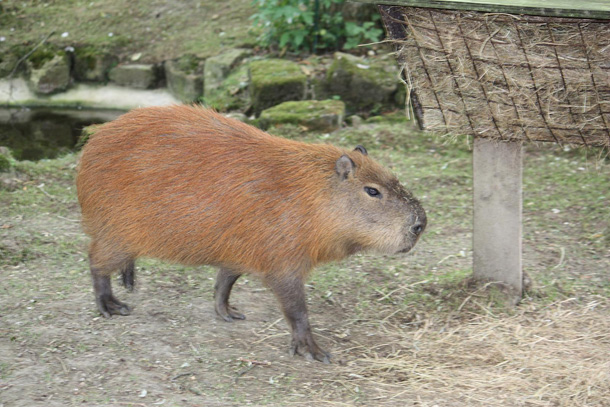
Capybara (Bryn Davies / Flickr)
As they are extremely social they live in groups of up to 100. As herbivores they pose no danger to anyone, unless you try to pick one up. Covered in reddish brown fur, they are pleasing looking stout creatures who amble around clearings like big lawn mowers.
2. The Puss Caterpillar
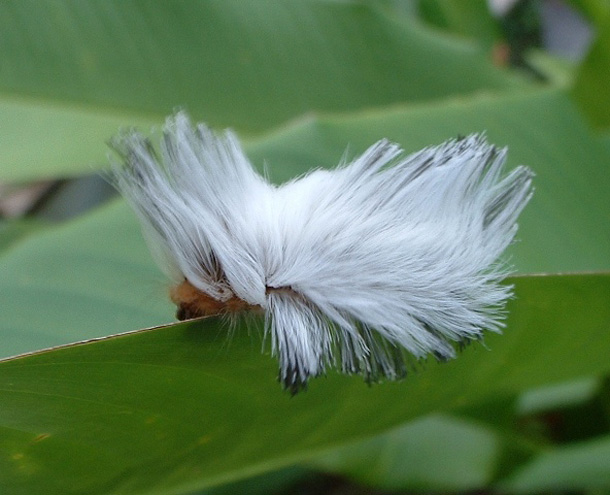
The Puss Caterpillar (Hickatee / Flickr)
If you ignore the unlovely name of this hefty invertebrate, it is a prime example of the oddness of animals of the rainforest. It will eventually become a flannel moth, but whilst in its young state looks like nothing so much as a hairpiece.
It’s as well to be cautious when peeking at it because like many caterpillars, those are not hairs but prickly spines that will cause irritation. This does not seem to aid camouflage so much as warn off predators and grabby people.
3. The Pink Dolphin

Pink Dolphin (Wikipedia)
Also known as the Amazon River Dolphin, this striking creature, being freshwater, plies his trade in all the rivers and channels. Apart from being freshwater, they are different to other dolphins in that they do not have a dorsal fin, but a hump, and can move their head from side to side. The name is literal, too - given enough exposure to the sun, a pink dolphin can match a flamingo in hue.
4. The Okapi

Okapi (Wikipedia)
Okapis are a very special creature. They are come from giraffe stock, and look like they could not decide on an outfit. They are dark in color with white stripes on the legs, so they can look similar to a zebra from far off. Okapies are extremely popular in various zoos throughout the USA and Europe.
5. Bagheera Kiplingi
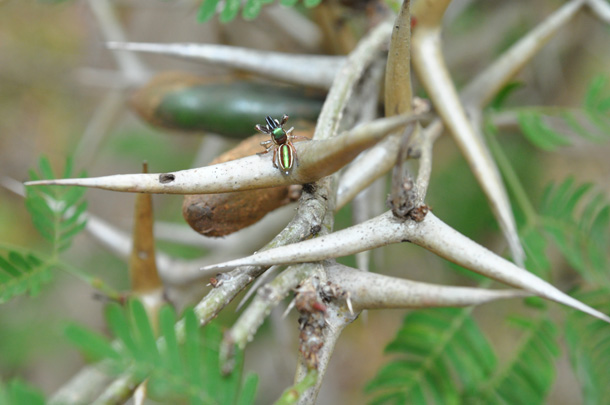
Bagheera Kiplingi (Max0rz / Flickr)
This creature certainly is odd. A jumping spider with bright colouring. However, it has one truly arresting characteristic - it is herbivorous and lives off Acacia. Sometimes it has to make do with what’s around, but it is unique in the spider world for being a plant eater. Not quite as scary as his brethren, is he?
Even though they sometimes need to revert to chowing down on grubs or cannibalism, they usually share a kind of mutual pact with ants that inhabit the same acacia, despite being mostly solitary.
6. Mata Mata
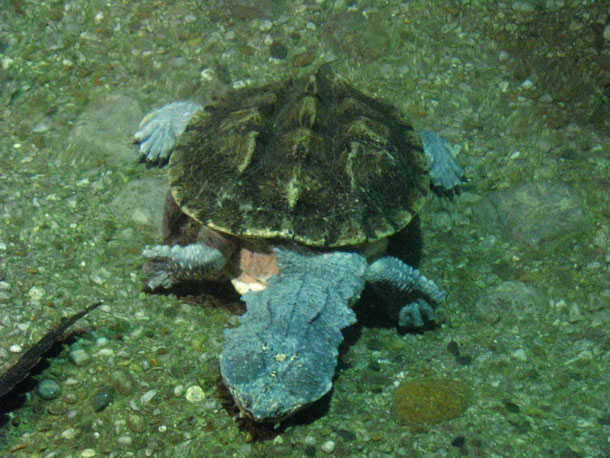
Mata Mata (MSVG / Flickr)
Ever seen one? It’s not surprising if you haven’t. These fresh water turtles are extremely skilled at camouflage. They are large and sedentary, with a flat head and shell covered in all manner of adornments.
They lie motionless in the water, imitating a log with their carapace and fallen vegetation with their head. When a fish goes by, they use their mouth as a vacuum to consume them. Clearly, a creature living to prove that appearances can be deceptive.
7. Glass Frogs
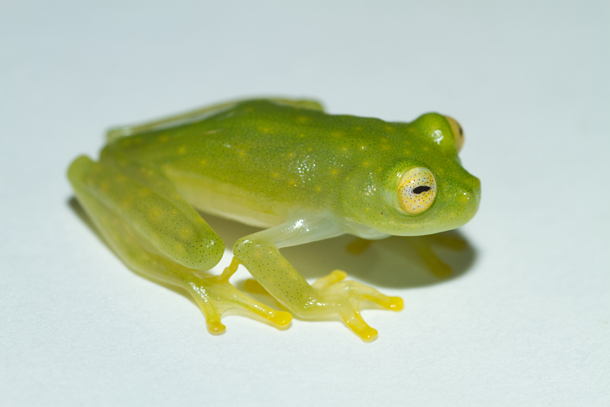
Glass Frogs (Wikepedia)
Living mostly in trees by streams, these guys are at first glance a simple tree frog and nothing more. They are generally green, no bigger than three inches in length, and would leap away at the first sight of you. Where they differ from other frogs is that the underside of their body is translucent; so much so that you can see the internal organs (some even develop translucent backs!). It’s not clear what evolutionary advantage this development conveys upon them, but it’s not every day you see a living creature with a see-through abdomen.
8. Pyrilia aurantiocephala
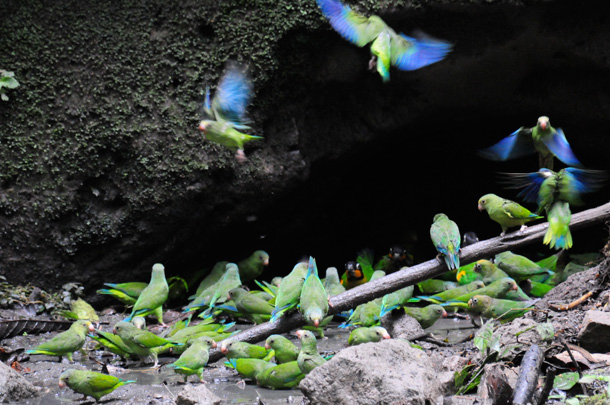
Pyrilia Aurantiocephala (VSmithUK / Flickr)
This bird hasn’t got a colloquial name yet as it is only newly identified, but it’s safe to assume the words ‘bald’ and ‘parrot will be in there somewhere. The bird itself has a wide array of colors on its body, but a totally bald head, giving it a quizzically stern look. Not very widespread, with the loss of its habitat the reason, sadly the relatively small populations are declining.
9. The Sloth
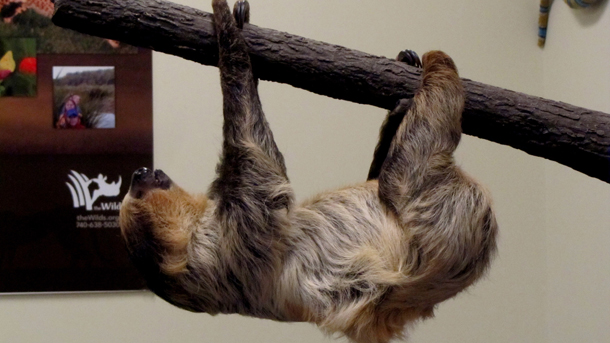
The Sloth (j33pman / Flickr)
A familiar animal because of its social associations with slowness and lethargy, but still interesting in its own lumbering way. Its hair actually grows in the opposite direction to most mammals, so as to afford protection against the elements when the sloth is dangling upside down from a perch.
Even though the Sloth is a by-word for laziness, whilst it does not move fast (six and a half feet per minute) and rarely leaves the trees, it’s recently been found they only sleep about ten hours a day. Also, as arboreal creatures it is rare to see them on the ground, but they are surprisingly good swimmers.
10. Candiru
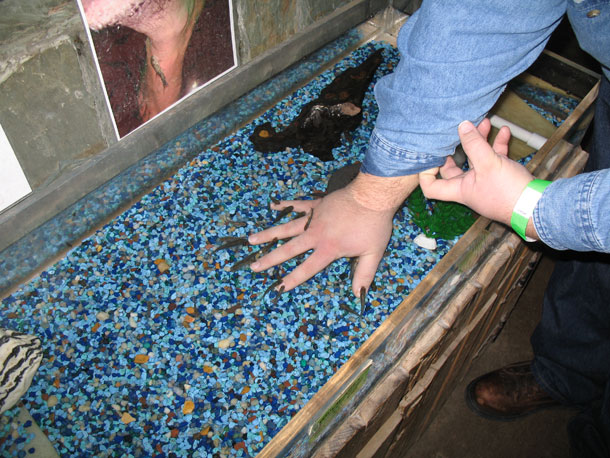
Candiru (hollyking / Flickr)
Saving the most unpleasant for last, this long, thin, and evil-looking fish is variously known as the Vampire or toothpick, from its antisocial behavior of invading the urethra of humans, Once lodged it will not be moved by anything less than surgical intervention.
There is, of course, conjecture about the veracity of a lot of the claims regarding these fish, especially as the same is often said of the piranha. In all probability though, its just another reason you might not want to take a dip in the Amazon.
author: Editorial Staff categories:
- Nature date: 2013-08-12T19:34:20Z guid: https://curiosityaroused.com/?p=1141 id: 1141 thumbnail: wp-content/uploads/The-Puss-Caterpillar-420x470.jpg title: 10 Weirdest Animals In The Rainforest url: /nature/10-weirdest-animals-in-the-rainforest/
A rainforest is truly an incredible place. An ecosystem of its very own, it contains a mind boggling variety of life. Aside from the obviously abundant tree and plant life, it is home to abundant varieties of amphibians, insects, mammals, fish, and birds.
Their vast area and incredible diversity is the rainforest’s premier ecological strength - the concentrated abundance of life is unmatched anywhere else in the world. Of course, in among these animals in the rainforest, there are certainly some that give us pause.
1.Capybara

Capybara (Bryn Davies / Flickr)
As they are extremely social they live in groups of up to 100. As herbivores they pose no danger to anyone, unless you try to pick one up. Covered in reddish brown fur, they are pleasing looking stout creatures who amble around clearings like big lawn mowers.
2. The Puss Caterpillar

The Puss Caterpillar (Hickatee / Flickr)
If you ignore the unlovely name of this hefty invertebrate, it is a prime example of the oddness of animals of the rainforest. It will eventually become a flannel moth, but whilst in its young state looks like nothing so much as a hairpiece.
It’s as well to be cautious when peeking at it because like many caterpillars, those are not hairs but prickly spines that will cause irritation. This does not seem to aid camouflage so much as warn off predators and grabby people.
3. The Pink Dolphin

Pink Dolphin (Wikipedia)
Also known as the Amazon River Dolphin, this striking creature, being freshwater, plies his trade in all the rivers and channels. Apart from being freshwater, they are different to other dolphins in that they do not have a dorsal fin, but a hump, and can move their head from side to side. The name is literal, too - given enough exposure to the sun, a pink dolphin can match a flamingo in hue.
4. The Okapi

Okapi (Wikipedia)
Okapis are a very special creature. They are come from giraffe stock, and look like they could not decide on an outfit. They are dark in color with white stripes on the legs, so they can look similar to a zebra from far off. Okapies are extremely popular in various zoos throughout the USA and Europe.
5. Bagheera Kiplingi

Bagheera Kiplingi (Max0rz / Flickr)
This creature certainly is odd. A jumping spider with bright colouring. However, it has one truly arresting characteristic - it is herbivorous and lives off Acacia. Sometimes it has to make do with what’s around, but it is unique in the spider world for being a plant eater. Not quite as scary as his brethren, is he?
Even though they sometimes need to revert to chowing down on grubs or cannibalism, they usually share a kind of mutual pact with ants that inhabit the same acacia, despite being mostly solitary.
6. Mata Mata

Mata Mata (MSVG / Flickr)
Ever seen one? It’s not surprising if you haven’t. These fresh water turtles are extremely skilled at camouflage. They are large and sedentary, with a flat head and shell covered in all manner of adornments.
They lie motionless in the water, imitating a log with their carapace and fallen vegetation with their head. When a fish goes by, they use their mouth as a vacuum to consume them. Clearly, a creature living to prove that appearances can be deceptive.
7. Glass Frogs

Glass Frogs (Wikepedia)
Living mostly in trees by streams, these guys are at first glance a simple tree frog and nothing more. They are generally green, no bigger than three inches in length, and would leap away at the first sight of you. Where they differ from other frogs is that the underside of their body is translucent; so much so that you can see the internal organs (some even develop translucent backs!). It’s not clear what evolutionary advantage this development conveys upon them, but it’s not every day you see a living creature with a see-through abdomen.
8. Pyrilia aurantiocephala

Pyrilia Aurantiocephala (VSmithUK / Flickr)
This bird hasn’t got a colloquial name yet as it is only newly identified, but it’s safe to assume the words ‘bald’ and ‘parrot will be in there somewhere. The bird itself has a wide array of colors on its body, but a totally bald head, giving it a quizzically stern look. Not very widespread, with the loss of its habitat the reason, sadly the relatively small populations are declining.
9. The Sloth

The Sloth (j33pman / Flickr)
A familiar animal because of its social associations with slowness and lethargy, but still interesting in its own lumbering way. Its hair actually grows in the opposite direction to most mammals, so as to afford protection against the elements when the sloth is dangling upside down from a perch.
Even though the Sloth is a by-word for laziness, whilst it does not move fast (six and a half feet per minute) and rarely leaves the trees, it’s recently been found they only sleep about ten hours a day. Also, as arboreal creatures it is rare to see them on the ground, but they are surprisingly good swimmers.
10. Candiru

Candiru (hollyking / Flickr)
Saving the most unpleasant for last, this long, thin, and evil-looking fish is variously known as the Vampire or toothpick, from its antisocial behavior of invading the urethra of humans, Once lodged it will not be moved by anything less than surgical intervention.
There is, of course, conjecture about the veracity of a lot of the claims regarding these fish, especially as the same is often said of the piranha. In all probability though, its just another reason you might not want to take a dip in the Amazon.